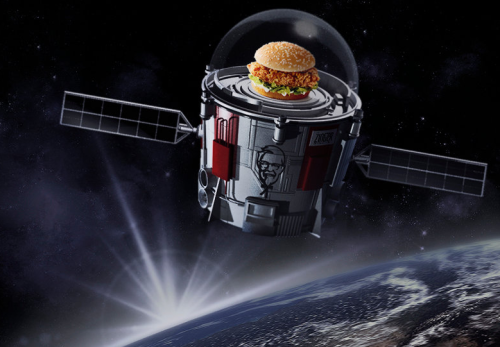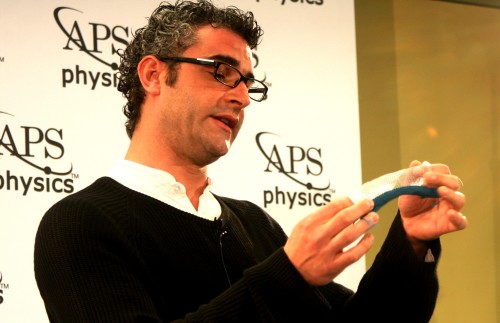Tag archives: biophysics
The February 2018 issue of Physics World magazine is now out
 By Matin Durrani
By Matin Durrani
You’ll be delighted to know that the February 2018 issue of Physics World is now out in print and digital format.
In our cover feature this month, science writer Jennifer Ouellette discovers how tiny midges can shed light on collective behaviour in physics. You can also discover from Helen Gleeson how physicists are seeking to create liquid-crystal contact lenses – and learn from Stephen Ornes more about the technological challenges of going to Mars.
Don’t miss either our interview with the physicist who heads Japan’s leading funding agency and find out from astrophysicist Elizabeth Tasker about her experiences as an overseas scientist in the country.
And our veteran North America correspondent Peter Gwynne assesses the impact that Donald Trump has had on US science, one year into his presidency.
Remember that if you’re a member of the Institute of Physics, you can read the whole of Physics World magazine every month via our digital apps for iOS, Android and Web browsers.
Let us know what you think about the issue on Twitter, Facebook or by e-mailing us at pwld@iop.org
View all posts by this author | View this author's profile
Physicists bag Australian and Senior Australian of the Year, Doomsday Clock ticks closer to midnight

Award winning: Australian of the Year Michelle Simmons (Courtesy: UNSW)
By Hamish Johnston
Today is Australia Day, when the prestigious Australian of the Year award is conferred. This year’s winner is the quantum physicist Michelle Simmons of the University of New South Wales who famously built a transistor from just one atom and also created what could be the world’s thinnest wire. Also honoured today is biophysicist Graham Farquhar of the Australian National University. He is Senior Australian of the Year for 2018 and an expert in photosynthesis. It looks like this will be a bonzer year for physics in Oz.
View all posts by this author | View this author's profile
The September 2017 issue of Physics World magazine is now out
 By Matin Durrani
By Matin Durrani
Some of the daily challenges facing women in physics are tackled in the latest issue of Physics World magazine, which is now out.
As well as a round-up from the recent International Conference on Women in Physics, which took place in Birmingham, UK, there’s a fascinating feature about the life of Jocelyn Bell Burnell. She discovered pulsars 50 years ago next month and became the first female president of the Institute of Physics, which publishes Physics World.
As Bell Burnell points out, “Fix the women!” is often seen as the solution to why women progress more slowly in physics than men. In fact, she argues, larger problems – notably institutional bias and poor policies – are to blame.
Don’t miss either our cover feature on the stunning images Cassini has been beaming back over the last few months before it plunges into Saturn on 15 September. We’ve also got a great Lateral Thoughts article by Daniel Whiteson, illustrated by PHD Comics artist Jorge Cham. Plus, find out how groups of cells move, communicate and organize themselves in networks.
Remember that if you’re a member of the Institute of Physics, you can read Physics World magazine every month via our digital apps for iOS, Android and Web browsers.
View all posts by this author | View this author's profile
Chicken sandwich goes stratospheric, socks for space, dressmakers have needle-sharp vision

Space sandwich: a Zinger floats high above Earth. (Courtesy: KFC)
By Sarah Tesh and Hamish Johnston
If you could put anything on a high-altitude balloon, what would it be? World View Enterprises has opted for a spicy chicken sandwich. The company plans to run balloon excursions to the stratosphere and on 21 June it will make its debut voyage carrying a Zinger sandwich from Kentucky Fried Chicken (KFC) – but with no-one on board to eat it. According to the New York Times the flight is tied in with KFC’s current space-based advertising campaign and the sandwich will spend at least four days in the stratosphere. As well as planning to charge tourists $75,000 per person for a ride, World View Enterprises says that its balloons could also be used to create an early warning system for tornadoes. (more…)
View all posts by this author | View this author's profile
Creating human organs on chips
By James Dacey reporting from Boston, Massachusetts
Having left a rain-soaked Bristol on Monday, I was greeted by an even more rain-soaked Boston on Tuesday. Fortunately, I spent my first day in the US under a roof at the Wyss Institute for Biologically Inspired Engineering. I was there to learn about an intriguing technology that reproduces the functionality of human organs on polymer chips about the size of a little finger.
View all posts by this author | View this author's profile
Physics graduate is just 14, high drama at the LHC, the physics of number two
By Hamish Johnston and Michael Banks
Carson Huey-You was just 11 years old when he arrived at Texas Christian University to study physics. Now, at the ripe old age of 14, he is about to graduate, according to an article in the Huffington Post. “I knew I wanted to do physics when I was in high school, but then quantum physics was the one that stood out to me, because it was abstract,” says Huey-You. Most American children start high school at age 14, but Huey-You was learning calculus by the time he was three – a subject usually reserved for high school seniors. And precociousness runs in the family because his younger brother Cannan is starting university in September aged 11. The siblings are delightful and interviewed in the above video.
View all posts by this author | View this author's profile
Frightening physics films, a furry physics doodle and an epic pub crawl
By Hamish Johnston
There are still 10 days to go until Halloween, but some physicists can’t resist getting into the spirit a bit early. Over at Symmetry, Kathryn Jepsen suggests a few scary physics films that would make for a spooky movie night on 31 October. They’re not actually real films, but rather a series of posters dreamt up at Chicago’s Sandbox Studio in collaboration with the illustrator Ana Kova. My favourite is Poltergauss (right), because trying to understand magnetism is terrifying.
View all posts by this author | View this author's profile
The September 2016 issue of Physics World is now out
By Matin Durrani
The cover story in the September 2016 issue of Physics World magazine – now live in the Physics World app for mobile and desktop – reveals the fascinating new field of “crowd breath research”, which can even shed light on how cinema audiences react during the changing scenes in a movie. You can read the article here on physicsworld.com too.
The September issue also shows how to do crystallography without crystals, explains how first data from the Gaia spacecraft could revolutionize astronomy (see the above video for more on that), and contains one physics teacher’s fascinating story about what she did to change her school’s gender balance.
Don’t miss either reader feedback on the potential impact of Britain leaving the EU on physics or Robert P Crease’s Critical Point column on why science denial is one of the most important issues in the US presidential campaign.
View all posts by this author | View this author's profile
3D-printed dog’s nose sniffs out why canines are excellent chemical analysers
By Tushna Commissariat
After a long trip in the US – attending the APS March meeting and visiting both the Maryland campus of the National Institute for Standards and Technology, as well as the Brookhaven National Laboratory in New York – I finally made my way back home yesterday. As I flew out of New York, I was reminded of my visit to NIST’s Surface and Trace Chemical Analysis Group, where researchers develop a variety of ways to detect contraband substances at airports and other public locations. While the team looks into a variety of ways to detect trace residues of banned substances such as drugs or explosives that may be found on people or objects – from mass spectroscopy to thermal desorption to vapour-sampling – my favourite was their canine research that led them to create a 3D-printed dog’s nose!
The everyday physics of knitting, ribbon-curling and more

Knit stitch: Frédéric Lechenault talks about the physics of knitted materials. (Courtesy: James Riordon/APS)
By Tushna Commissariat in Baltimore, Maryland, US
You may think that a simple occurrence such as a tree shedding its leaves or an everyday activity such as knitting or ribbon-curling does not involve a great deal of physics, but you would be wrong. In a press session here at the APS March meeting entitled “The physics of everyday life”, three different groups of researches talked about the unexpectedly complex physical principles that govern all of the above mentioned instances.
Sunny Jung of the Bio-Inspired Fluid Lab at Virginia Tech in the US studies the shapes of different leaves and the thickness of their “petioles” or stalks – both of which determine the stresses a leaf can withstand on a windy day and what happens when it ultimately falls. Jung’s team studies this because leaves are actually very good at withstanding all kinds of stress and strain without buckling – something that could be applied to large man-made industrial objects such as suspended road-signs.
The researchers found that slender leaves are more likely to bend under high winds, whereas a flat leaf is more likely to twist at the stem before falling. They also discovered that the length of the stalk is determined by the size of the leaf, with larger leaves needing longer stems so that sunlight can cover more of their surface area.

